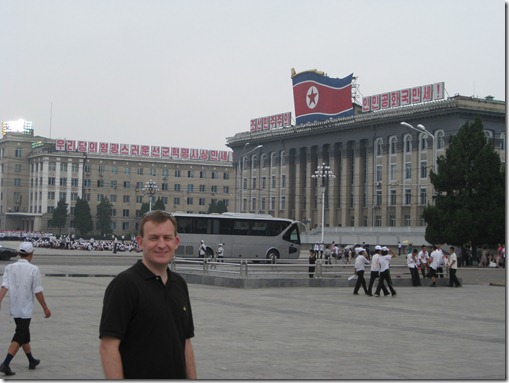There is KJI in the middle – he was even born in uniform
Actually, he was probably born in the USSR during the war.
5. Pyongyang the Potemkin Village?
The usual line is that Pyongyang is a potemkin village compared to the rest of the country. I can’t say, but I think so. Unfortunately, we only saw the capital, Nampo, and the Mt. Paektu area. And what we saw was quite controlled of course. We were told at certain points that we were not allowed to photograph out the bus windows. But honestly, I didn’t see any extreme poverty. I certainly didn’t see anything like what I saw in southern Africa or India. There was nothing like the gigantic slum-and-shack ‘city’ around Mumbai that is a terribly depressing shock the first time you see it.
My impression instead was that almost everything, beyond the most important government buildings in the elite district around Kim Il Sung Square, was run-down – the sort of crappy, broken down socialist world of faceless, concrete block ‘living units’ portrayed in A Clockwork Orange. Just as Alex lived in “’Municipal Flat Block 18A, Linear North,” so do most North Koreans. In our hotel, there was even restaurant no. 1, no. 2., no. 3, and no. 4. Apparently the Presidium of the Fourth Committee for Ideology in Quadrant B12 decided in the Eighth Five Year plan that restaurants in NK must be as bland as possible…
Like so many of the ex-communist countries I’ve visited, the architecture was hideous – concrete was everywhere, and it was cheaply made, so everything seemed to cracking and crumbling. It reminded me of Mozambique or Vietnam – desperately in need of a good cleaning, more humane architecture, and a lot of foreign investment to tighten things up. And the architecture that was in good repair was that typical soul-crushing communist gigantism. What better way to remind you of your insignificant role as a cog in the KIS machine than epic concrete monumentalism towering above you. Awful.
6. Moral Discomfort.
The guides are smart enough to realize that foreigners, especially westerners and/or the deeply religious, would have a fair amount of trouble if we were expected to bow to images of KIS and KJI as often as North Koreans must. Do the North Koreans really believe it? Who knows. The problem of ‘hidden preferences’ is pretty obvious in NK. But foreigners have a little bit more room to dissent. I made sure to roll my eyes occasionally or drift away from the group when the presentations got more over-the-top than usual. We only had to bow twice – once at Mansudae, which is obligatory for any foreigner visiting, and once near Mt. Paekdu. There was a opportunity to buy flowers with the bowing at Mansudae, which I forewent. A bit of resistance.
The other obvious problems are one, going to NK itself, and two, how to respond to guides and other North Koreans as you meet them and they are polite and pleasant with you. On the first one, I wrestled with this a bit. Travelling to North Korea is expensive – $3-400 a day, the bulk of which goes to the regime. So in going you are supporting it I guess, which still makes me very queasy. But I have to say that my morbid curiosity won out. I didn’t make it the east bloc before the Wall fell, and China and Vietnam hardly count anymore. So I was terribly curious to see a stalinist system before it disappears, which I do think one day will happen in NK. But it was a morbid curiosity – you go not to take a vacation or tour some exciting, exotic place. You go to see what a mess it is. It’s ‘disaster tourism’ – like those people who took bus tours of the devastation wrought by Hurricane Katrina. You couldn’t care less about KIS, instead you are going to see how the regime obsesses over KIS. You go to observe the personality cult and wonder about its freakishness, not to actually participate in it. This is why I went to see Mao and Ho in China and Vietnam too; as a political scientist, I found it absolutely fascinating, in a very, very disturbing way, to watch it all.
The other issue is how to respond to the North Koreans you meet. Inevitably the people you meet are pleasant and polite. We drank beer with our guides, small talked with the drivers, chatted with students we meet, etc. Inevitably this humanizes them, which is presumably one reason NK permits such tourism and why SK dislikes foreigners going. Do I feel like NK is any less awful and barbarous after talking with people in NK? Were we Lenin’s ‘useful idiots’ to be deployed in propaganda later to show the foreigners do in fact find NK a nice place?
More in the 3 days.
Cross-posted at Asian Security Blog.
Associate Professor of International Relations in the Department of Political Science and Diplomacy, Pusan National University, Korea
Home Website: https://AsianSecurityBlog.wordpress.com/
Twitter: @Robert_E_Kelly




0 Comments